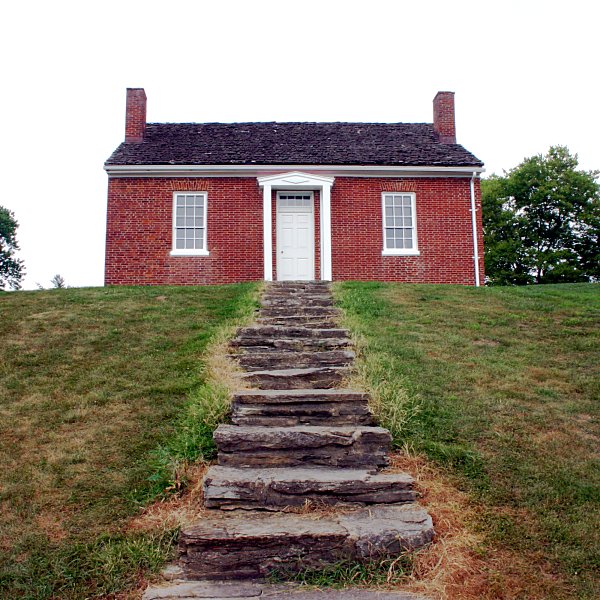
Rankin House looking up the path
Credit: Rdikeman at the English-language Wikipedia, CC BY-SA 3.0, via Wikimedia Commons
The directors of the MFA program for Creative Non-Fiction at King’s College, Dalhousie University, Halifax, Nova Scotia scheduled a night of reading by the second-year students. We each had a five-minute slice of time to read from our work. My book is centered on Lexington, the greatest stallion of his time and one of the greats of all time, and his owner R. A. Alexander.
The time frame is antebellum Kentucky through the Civil War. I chose a condensed reading from a chapter on Abolitionists and the Underground Railroad:
Liberty Hill
A single candle in a brass candlestick sat on a table, cozied up to one of two south-facing windows. The window had a magnificent view of the Ohio River, flowing westward past the community of Ripley, on to Cincinnati, and forming the watery border between slave state Kentucky and free state Ohio.
John Rankin, minister and abolitionist, had chosen this location for its commanding view. Located on a steep hill, 540 feet above Ripley, his house was visible to the riverside town below, and to those in Kentucky, who waited for darkness to run to freedom.
Rankin, and his family, received any soul trying to liberate themselves from enslavement. To signal it was safe to cross, a candle placed in the window, or a lantern outside, meant warmth, clothing, and food awaited.
The Rankin House was a stop on the Filson Historical Society’s tour of important places on the Underground Railroad. All of us from the bus crowded into the tiny abode, milling through small rooms, jostling to hear the docent, as she described how the newly arrived persons removed and burned their telltale slave cloth in the fireplace. I craned my neck to catch a glimpse of the replacement garments for free Black men and women who then climbed into the back of a wagon, or onto a horse, and were hurried away to avoid slave catchers and bounty hunters, who swarmed the town like wasps around a beehive.
The tour wrangler announced the bus would go to the John Parker House in Ripley. Patrons were welcome to walk from Rankin House to town using the original route climbed by those bent on self-liberation. Misty rain had been falling, and he informed, “the downhill trail could be slippery, especially after the stairs end.”
His warning deterred all but me and another woman travelling alone. We set off down stone steps, onto wooden stairs, and then the real journey began.
For the most part, the trail was greasy, slick mud. One wrong step and the path became a slimy, rock-strewn, S-curving luge run right to the bottom. In less than 20 feet, my walking partner slipped and fell twice. With hands and jeans muddied, she scrambled to stay on her feet.
I asked her to wait while I thrashed about in the woods and returned with two sticks to aid our descent.
“Follow me. Put your feet where mine were.”
Slowly, painstakingly, we inched down the hillside, finally emerging onto a paved road, grateful to be on solid ground.
The presentation had already begun at Parker House.
Born into slavery in Virginia, John Parker was sold South by the plantation owner—his father, who sold his mother to a different owner. Joining a coffle of other enslaved people, eight-year-old Parker walked over the mountains of Virginia all the way to Mobile, Alabama.
Parker’s keen intellect and strong spirit drove him to find a way to pay for his freedom. He learned to read and to mould iron. Once he had his manumission papers, he wasted no time heading for Cincinnati, an active hub of the underground railroad. He wanted to be involved.
Contrary to commonly held notion, much of the hiding and conducting was done by free blacks, and not whites.
Parker soon moved to Ripley where he continued to work as an iron moulder by day. By night, he was the most fearless of conductors, making forays into Kentucky despite the bounty on his head.
For those who wanted to escape, the information grapevine was as real as it was elusive. Word found its way to Parker, but many individuals simply showed up. They arrived by stolen skiff; or during dry summer after wading through shallow parts of the Ohio River; or walking across winter ice, armed with the whisper:
“Look for the light on the hill.”
Outside John Parker’s house, I crossed the flat plain heading toward the river, and reaching the embankment’s edge, turned to look up at Liberty Hill. Could the home be seen from the river? Scanning the horizon, the red brick house was miniscule but visible. A candle in the window likely appeared as a mere speck, and an outdoor lantern reduced to a flickering glimmer.
I imagined myself in the blackness of the new moon, a favourite time for the enslaved to travel—the moon playing her role in cloaking escape.
The town of Ripley had few, if any streetlamps in 1850; no ambient glow to wash buildings with shadow. High on the hill, one spot of light stood out like a beacon. For eyes desperately hunting for a guide to freedom, that ray of hope offered reassurance:
Yes—this is the way.
Keep going.
Keep going.

Photo Credit: Woodcut of Ripley, Ohio and Rankin House reproduced by permission of the Ohio Historical Society. Hagedorn, Ann, Beyond the River: the Untold Story of the Heroes of the Underground Railroad,pg144. New York: Simon & Schuster Paperbacks. 2002.
